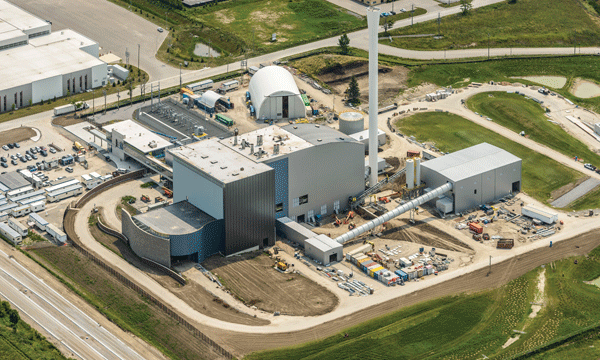
A cleaner burn: Durham-York’s alternative to landfills
By PLANT Staff
Industry Sustainability Energy Government Resource Sector clean energy energy Landfill recycling renewable energyA regional energy centre will process 140,000 tonnes of solid waste and create enough renewable energy to power 10,000 homes.
A Michigan landfill will no longer be the final resting place for most non-recyclable municipal waste from Ontario’s Durham and York regions.
This fall, the $284 million Durham-York Energy Centre will be commissioned, an energy-from-waste (EfW) facility that will process 140,000 tonnes of post-diversion residual waste in Clarington, Ont.
The facility will use thermal mass technology to burn household waste that isn’t recycled, but the process also produces high-pressure steam, which is fed through a turbine generator to power the plant.
Durham and York Region will co-own the EfW facility and Covanta Energy Corp., a New Jersey-based operator of energy from waste projects, will manage it on a 20-year design-build-operate contract. Covanta anticipated the creation of nearly 700 direct and indirect jobs during construction and more than 40 permanent plant operator positions when the facility comes online.
Thermal mass burn technology involves feeding municipal solid waste into a furnace where it’s burned at temperatures above 1,000 degrees C. The remaining ash is shipped to landfill or reused in product manufacturing.
Durham will process up to 110,000 tonnes each year and York will handle the remaining 30,000 tonnes.
Here is how the process will work: when trucks arrive at the facility, garbage is dumped into a pit, where two crane grapples operated from a nearby control room, stir then feed it into one of two combustion chambers, where the trash generated by more than 500,000 people will be reduced to ash in about an hour.
Meanwhile, heat from the combustion chambers boils water in surrounding pipes to create steam, driving a GE turbine-driven generator to create 17.5 megawatts of renewable energy annually. Excess energy will be sold to the provincial power grid under a power-purchase agreement with the Ontario Power Authority. The electricity will go though Hydro One’s 44-kilovolt distribution system at the Wilson Transfer Station to power up to 10,000 homes, helping to offset the facility’s operating costs.
A planned district heating system will also produce heat equivalent to the needs of 2,200 homes.
After the combustion process, heavy ash falls into a recovery area where it’s picked through for leftover metals, which are sorted and sold.
Gas and fly ash are fed through a system that injects lime to reduce acidity and carbon to bind with heavy metals such as mercury. In the bag house, the gas is forced through fabric filters that capture particulates before the clean exhaust exits the stack. Remaining ash, which is about 70% less material by weight and 90% less by volume, is sent to landfill and used as cover rather than newly mined gravel, but it can also be used as filler in construction materials such as concrete or asphalt.
The energy centre hasn’t been well received by all. At a ground-breaking ceremony in 2011, protesters had to restrained by police, arguing the energy-to-waste plant was a glorified incinerator and that its emissions pose health hazards, create an ongoing demand for waste, discourage recycling, and they’re incredibly expensive.
But the regions, as well as Covanta Energy, are adamant the energy centre will meet stringent environmental standards and reduce greenhouse gas emissions. It’s equipped with a state-of-the-art advanced air pollution control system that includes a selective non-catalytic reduction (SNCR) system to reduce nitrogen oxide (NOx) emissions.
Lacking landfill space
The plant is part of an ongoing trend of energy-from-waste facilities popping up across North America where growing residential development lacks landfill space. There are more than 85 EfW facilities in operation in the US alone, and on the West Coast, Covanta’s Burnaby Waste-to-Energy facility (commissioned in 1988) processes 285,000 tonnes of solid waste that’s converted into 940,000 tonnes of steam to produce up to 170,000 megawatt-hours of electricity for Metro Vancouver.
The project is funded by $213 million in federal Gas Tax funds, which have been used to pay back a loan needed for construction. The fund is one of the only permanent sources of funding for municipal infrastructure, and provides Ontario with $744 million per year. The City of London also used gas tax funds to build its Regional Materials Recovery Facility.
Commissioning the facility has been a long journey that started in 1999 when Durham decided it wouldn’t develop any new landfill sites. Fifteen years later, the region has an alternative that’s a lot closer to home than sending waste on a long trek down the 401 to Michigan.
This article appears in the September 2014 issue of PLANT.
Comments? E-mail jterrett@plant.ca.


